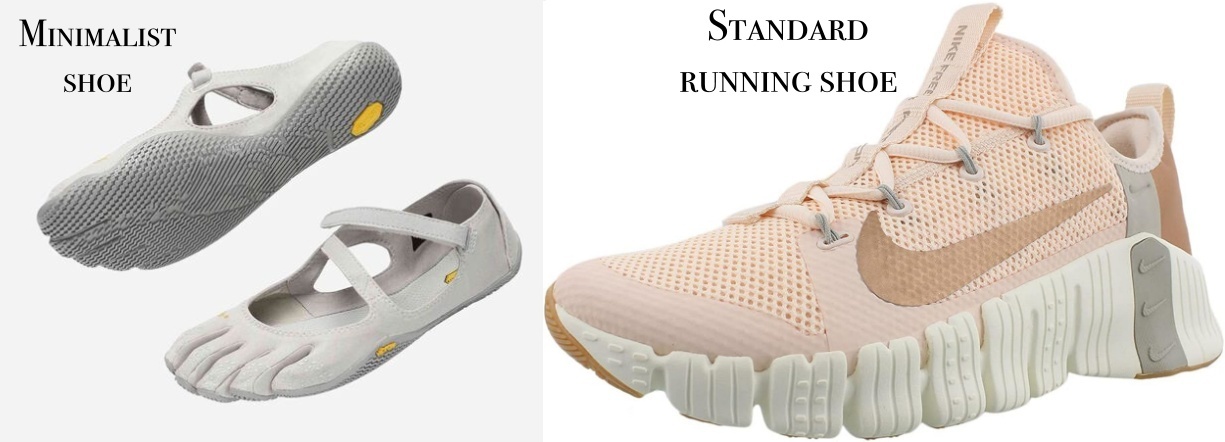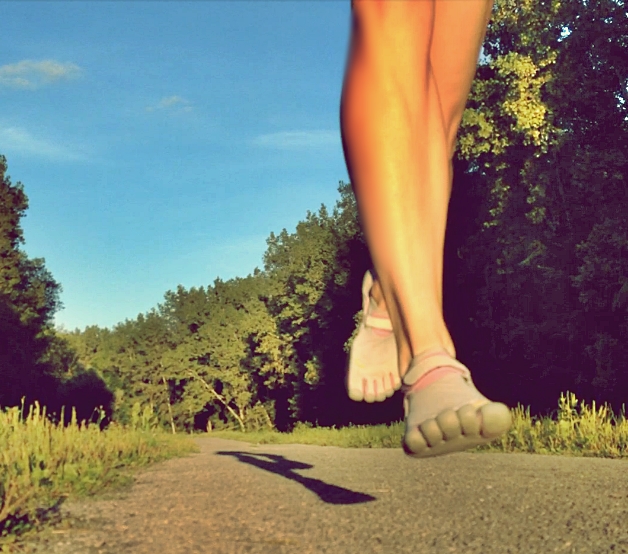Contrary to popular belief, barefoot-inspire running shoes, also known as minimalist running shoes, which have a flat, flexible, paper thin sole, were found to be safer than running shoes with thicker cushioning!

One of the many studies that demonstrate a strong association between standard running shoes and high-impact mechanics came from a study in the British Journal of Sports Medicine which reported that runners who wore cushioned, but very flexible running shoes (Nike Free 5.0) experienced 3 times as many injuries as runners who wore a neutral, stiffer, cushioned running shoe and had 5 times more injuries than runners who wore barefoot running shoes (the Vibram Fivefingers Bikila).
What accounted for the improved mechanics in the runners who ran in barefoot running shoes?
Less shoe cushioning, especially under the heel, is correlated with a non-heel strike landing during running. Other work reported that runners who ran barefoot, or in barefoot running shoes for the first time, avoid heel strike and adopted a forefoot strike landing.
The runners in the Vibrams had less of a heel strike and adopted either a midfoot or a forefoot strike landing pattern to reduce impact peaks (burst of high impacts) and heel pressures. Unlike the thickly cushioned Nike Free’s, the Vibram barefoot shoes have a very thin that lets you feel the ground, thereby improving detection of impact components, enabling the central nervous system to reflexively prevent discomfort during running.
Shoe cushioning causes impact-moderating behavior to fade, resulting in less responsive reflexes and impulsive landings.
The heel-toe differential of the Nike Free 5.0 is also high enough to facilitate heel strike, inflicting more shock on the body since the shoe has less under-heel cushioning than regular running shoes
The Take Home Message
As a cautionary word of advice, heel strikers with no intentions of switching to forefoot running should avoid the Nike Free because they encourage heel strike and lack under-heel protection.
 Conversely, runners planning to go minimal are better off going pure minimal, getting as close to the barefoot experience as possible because adequate biomechanical modification depends on clear feedback between your feet and the ground.
Conversely, runners planning to go minimal are better off going pure minimal, getting as close to the barefoot experience as possible because adequate biomechanical modification depends on clear feedback between your feet and the ground.
More From Run Forefoot:
- Great Minimalist Shoe for Long Distance Running
- Ankle Injury Linked to Running Shoes with Soft Midsoles
- How Heel Strike Running Hurts the Lower Back
- Runners Knee
References:
Kalat, JM. (2007). Biological Psychology, Ninth Edition.
Robbins, SE. and Guow, GJ. (1991). Athletic footwear: unsafe due to perceptual illusions.
Ryan et al. (2012). Examining the injury risk and pain perception in runners using minimalist footwear.
Bretta Riches
BSc Neurobiology; MSc Biomechanics candidate, ultra minimalist runner & founder of RunForefoot. I was a heel striker, always injured. I was inspired by the great Tirunesh Dibaba to try forefoot running. Now, I'm injury free. This is why I launched Run Forefoot, to advocate the health & performance benefits of forefoot running and to raise awareness on the dangers of heel striking, because the world needs to know.
Latest posts by Bretta Riches (see all)
- Can You Run In Barefoot Shoes? Yes, But DON’T Heel Strike! - 21/07/2024
- Why Cushioned Running Shoes Are Really Bad for Your Feet - 19/07/2024
- Do Cushioned Running Shoes Cause Injuries? - 17/07/2024

Leave a Reply